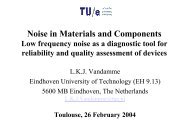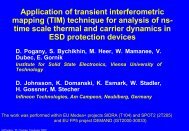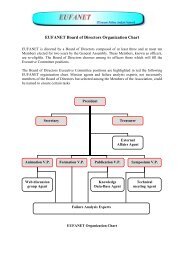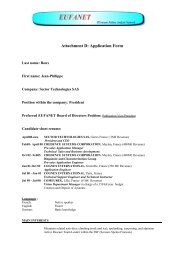Current Induced Failure Analysis of Ni-based Microinsert ...
Current Induced Failure Analysis of Ni-based Microinsert ...
Current Induced Failure Analysis of Ni-based Microinsert ...
You also want an ePaper? Increase the reach of your titles
YUMPU automatically turns print PDFs into web optimized ePapers that Google loves.
1<br />
<strong>Current</strong> <strong>Induced</strong> <strong>Failure</strong> <strong>Analysis</strong> <strong>of</strong> <strong>Ni</strong><strong>based</strong><br />
<strong>Microinsert</strong><br />
Interconnections for Flip Chip Die on Wafer<br />
Attachment.<br />
V. Mandrillon, A. Reverdy, D. Arias<br />
G.Tartavel, H.Boutry
2<br />
Overview<br />
• Introducing <strong>of</strong> CEA- LETI <strong>Ni</strong>ckel Micro insert Wafer level stacking<br />
technology & experimental set-up<br />
• Implementing <strong>of</strong> specific reliability characterization and reviewing<br />
results<br />
• <strong>Failure</strong> <strong>Analysis</strong> : qualifying lock-in Thermography to localize failures<br />
• Tests have been performed on few samples to investigate analysis<br />
flow
3<br />
CEA-LETI, <strong>Ni</strong>ckel Micro insert Wafer level stacking technology :<br />
32 contacts daisy chains test system<br />
1- Epoxy Glue dispense<br />
2- Flip Chip assembly<br />
4 x 4 <strong>Ni</strong> insert<br />
contact matrix<br />
( 6 µm)<br />
3- Thermo-compression<br />
- 40 N per chip 70 mN per <strong>Ni</strong> Micro insert<br />
- Epoxy Curing 180 °C during 10 minutes
4<br />
Electrical contact analysis<br />
Design <strong>of</strong> the 32 contacts daisy chain test samples – enabling electrical<br />
characterization
5<br />
Good die selection after parametric test<br />
Good dies have been selected for the following reliability study
6<br />
Reliability Characterization<br />
<strong>Current</strong> / temperature stress setup<br />
> Reliability study has been adapted to technology specifications<br />
•The voltage versus current characteristics <strong>of</strong> the daisy chain is linear at least up to 500 mA<br />
and up to 100°C .<br />
•The Resistance value <strong>of</strong> the contacts change by 20 % between 3 and 3.7 mOhm when the<br />
contact undergoes a temperature increase between ambient and 100°C . This phenomenon is<br />
reversible and can be attributed to the temperature dependence resistivity <strong>of</strong> the materials.
7<br />
<strong>Current</strong> Stress tests & <strong>Failure</strong>s (1/2)<br />
<strong>Current</strong> stress tests for [A] 100°C at 500 mA and [B] 100°C at 750 mA<br />
Characterization <strong>of</strong> the corresponding failure mechanisms<br />
A. A failure <strong>of</strong> the stack is created under a 500 mA current stressing at 100°C after stress<br />
durations ranging between 50 to 150 hours.<br />
B. A failure <strong>of</strong> the stack is created in a few tens <strong>of</strong> seconds under a 750 mA current<br />
stressing at 100°C.
8<br />
<strong>Current</strong> Stress tests & <strong>Failure</strong>s (2/2)<br />
Detailed segmented monitoring <strong>of</strong> the 32 contacts daisy chain failure at 500 mA<br />
DC set-upconstant<br />
current<br />
Different<br />
Segments <strong>of</strong><br />
daisy chain<br />
Tension (V)<br />
2- Higher<br />
resistance<br />
1- Open<br />
Time (h)<br />
2 failure types<br />
1- <strong>Failure</strong> <strong>of</strong> contact n° 1 typical for electromigration<br />
2- Degradation <strong>of</strong> electrical contact resistance in segments :<br />
4 to 8 and 8 to 12<br />
Next:<br />
localizing<br />
faults
9<br />
2<br />
<strong>Failure</strong> <strong>Analysis</strong> solution - Fault localization using Lock-in<br />
Thermography<br />
• Non Destructive “Through<br />
package” solution<br />
> Using Lock-in Thermography<br />
V<br />
Simplification <strong>of</strong> Lockin<br />
Thermography<br />
technology<br />
IR-image (V = <strong>of</strong>f)<br />
IR-image (V = on)<br />
“on-images” – “<strong>of</strong>f-images”<br />
V<br />
1<br />
xy defect<br />
localization<br />
t p<br />
(f lock-in<br />
)<br />
only temperature<br />
differences are detected<br />
t surface<br />
0<br />
IR images impacted by emissivity and not<br />
enough sensitive – no fault detection<br />
t<br />
thermal delay<br />
defect depth (z)<br />
* Acknowledgements to CIMPACA to enable access to ELITE system
10<br />
Why and When Lock-in Thermography – and technology<br />
requirement for 3D package<br />
• Lock-in Thermography is<br />
<strong>based</strong> on electrical<br />
activation <strong>of</strong> the fault<br />
• Sensitivity & Resolution are<br />
required for 3D packages<br />
– Multiples publications in<br />
ESREF/ ISTFA<br />
• Finding fault in 3D stack!<br />
• Lock-in Thermography also<br />
enables:<br />
Thermal design support<br />
(identifying hot spot)<br />
Complementary defect<br />
localization technique on<br />
silicon<br />
“emissivity”<br />
measurment<br />
Not Enough<br />
Sensitivity<br />
Need Lock-in<br />
analysis<br />
Need camera<br />
sensitivity<br />
Lock-In<br />
Thermography<br />
Hot Spot detected<br />
Enough Sensitivity
11<br />
Fault localization using IR lock in thermography<br />
Localization <strong>of</strong> the daisy chain failure at 500 mA<br />
Chip B7 Lock-in thermography imaging (0,5Hz,<br />
20min, 1V – 125mA) – thresholded phase image<br />
superimposed on basic IR image<br />
Lock in thermography allows localization <strong>of</strong> resistance<br />
degradation <strong>of</strong> contact n° 5 and n° 10<br />
> Sensitive to low resistive faults<br />
* Acknowledgements to CIMPACA to enable access to ELITE system
12<br />
Fault localization using IR lock in thermography<br />
Localization for the daisy chain failure at 750mA (1/2)<br />
IR image quality<br />
impacted by<br />
surface quality<br />
Lock in thermography allows<br />
localization <strong>of</strong> resistance degradation<br />
<strong>of</strong> contacts n° 5 , 8, 9, 10, 14 and 19<br />
Chip C9 Lock-in thermography imaging (0,5Hz, 2min, 1V – 6mA)<br />
– thresholded amplitude image superimposed on basic IR image<br />
Phase image support<br />
analysis – indicating<br />
different ‘time delay’<br />
> Differentiating a failure<br />
on the top vs on the<br />
bottom<br />
Phase images - 5x lens (0, 3µm pixel),<br />
0.5Hz lock in frequency, 3 min @<br />
500mV<br />
* Acknowledgements to CIMPACA to enable access to ELITE system
13<br />
Fault localization using IR lock in thermography<br />
Localization for the daisy chain failure at 750mA (2/2)<br />
> Resolution sufficient to resolve single vs multiple failure micro-pillar<br />
IR image quality<br />
impacted by<br />
surface quality<br />
Overlay <strong>of</strong> topology image, with amplitude image 10x lens,<br />
0.5Hz lock in frequency, 5 min @ 500mV
14<br />
Default cross section analysis<br />
SEM imaging at failure location for failure analysis ( 750 mA stress current)<br />
IR image quality<br />
impacted by<br />
surface quality<br />
• 750 mA stressing seems to show delamination rather than electromigration<br />
Local heating
15<br />
Conclusion<br />
• CEA- LETI <strong>Ni</strong>ckel Micro insert Wafer level stacking technology is<br />
mature<br />
• Reliability study adapted to this technology<br />
• Lock-in Thermography enable fault localization through package<br />
– Providing sufficient sensitivity to low resistive fault<br />
• Following reliability study will support better characterization <strong>of</strong> fault<br />
mechanisms













